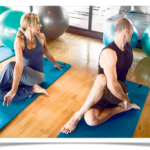
by cjxpadmin | Mar 1, 2012 | First Issue, March 2012 Magazine
 You know how it starts. “I need to rest; a small nap after work won’t hurt.” Maybe a “I don’t have time to work out, I’m busy with work all day!” and my fave “It’s just an innocent cookie to tide me over till lunch, what could it hurt?”
You know how it starts. “I need to rest; a small nap after work won’t hurt.” Maybe a “I don’t have time to work out, I’m busy with work all day!” and my fave “It’s just an innocent cookie to tide me over till lunch, what could it hurt?”
However it happened, you are now out of shape. Don’t worry though! The first step is admitting that you could use some help. And that’s where we come in. We are going to debunk some myths that will hopefully make getting fit a little easier while you work!
Myth 1: You have to do an hour of cardio all at one time to get the benefits.
Truth: Wrong. Though doing it one time is pretty ideal, you can fit in 10 minutes anywhere! Do some jumping jacks on your break. Go up and down the stairs of your office building. Morning classes? Try walking the long way to your class instead of picking the closest parking spot. Don’t have time early in the morning? If you’re a night owl, get your groove on before bed! It’s all about getting your blood pumping when you can. Some activity is better then no activity.

Myth 2: All you have to do is exercise and you’ll lose weight.
Truth: If only that were true. While you can be healthy at any size, if you want to lose weight around your middle or get into those jeans you wore in high school, you may have to give up grandma’s cookies — at least for a while. The best way to stave off snacking problems is to keep healthy snacks around. Instead of grabbing those Oreo cookies, maybe some apple or orange slices will do. Or if you have to have a sweet treat, you can now buy 100 calorie packs of cookies, crackers, and a lot of other snacks. Most cravings come about because you want something you can’t have at the moment. No one sets out to eat a whole can of Pringles, but by keeping a smaller can, you can have your cake or chips and eat them too!
Myth 3: You have to do aerobics.
Truth: If hopping around a gym in a leotard and 80’s like onesies is not your bag, try playing soccer. Join a martial arts class or join a basketball club. Not a sports fan? Zumba is a style of aerobics that’s more like dancing. Pilates is a great choice if you want to work out and relax. Too ambitious for you? Walking around the black for 30 minutes is another way of getting your blood going. You can also take the kids if you’re one of those busy parents who can’t find a sitter. Did we mention jumping jacks for 10 minutes? Awesome….

Myth 4: You need to join a gym to get fit.
Truth: By no means do we want you to throw away your gym membership, but for those of you who are tight on money or you’re not a joiner, there is hope. You can work out from any space. Like say for instance…your living room! That’s right! You don’t need a ton of equipment to get in shape. You can use towels for resistance bands, chairs for back and arm work and the floor for ab work. There is literally tons of free information about working out from home. The only thing that’s stopping you is you!
Myth 5: If I’m not sore, then I didn’t work out properly.
Truth: Okay, yes, if it’s too easy, you may want to work out a bit more. But soreness is caused by tiny tears in your muscle fibers. If you switch up your routine every once in a while, then, some soreness is to be expected. However, being sore after every work out means you’re not allowing your body to heal. Your muscles need a break or they won’t get stronger. Work on a different muscle group while another one is healing. You’ll still get your workout in, but it’ll give your body time to heal.
Myth 6: I’m hungry!
Truth: True, you might be hungry. If so, you should eat — no question about it. But! Before you go for that gyro, drink a glass of water. Sometimes that craving for food is actually a craving for water. So whenever you’re hungry, grab some agua and give it a few minutes. If you’re still hungry, get something to eat. It doesn’t have to be a four course meal, but there is nothing good about going without food for the sake of weight loss.
Myth 7: Water isn’t that good for you.
Truth: While we’re on the topic of water, there is currently a rumor that water isn’t that good for you.

by cjxpadmin | Mar 1, 2012 | March 2012 Magazine
By Sheena Williams
“I don’t have the skills.”, “They won’t hire me”, or “I’m not cut out for this type of work.” Why don’t you have the skills? How do you know they won’t hire you? Who told you that you were not cut out for that type of work? Sometimes we can be our own worst enemy. There are doubts that every woman has at times that keep them from not only being good at what they do, but it keeps them from being great. Everyone has their problems, there is no denying that, but there is no issue that cannot be improved upon or resolved. The first step is believing that you can accomplish anything you set out to do. Once you start believing that you can do anything, your employer will believe in you as well.

Step 1: Take a deep breath. Work can get stressful. The kids are asking for something, your husband needs help with a presentation he’s putting together, or your term paper is due. There are days when life can get pretty intense, and that is when it is most important for you to take a deep breath and center yourself. Taking 5 minutes just to do some deep breathing can get you ready to face the rest of your day.
Step 2. Know your strengths. If you are only focused on the things that you can’t do, then you will never get to the things that you can do. Okay, you may not be the greatest cook, but you were organized enough to get all of the recipes that you want to try arranged in neat subsections and categories such as lunch, dinner and appetizers. You may not be the greatest typist, but you organized the company Christmas party. Public speaking makes you break out in a cold sweat, but that speech you wrote for your boss last week got him rave reviews in the local newspaper. By focusing on your strengths and your abilities, it will give you more confidence to tackle the bigger things in life.
Step 3. Be nice to others. Having a bad self-image is being grouped with excuses for not being nice to others. Not cool. If you’re having a low self-image day, it does not give you the license to make someone else’s day miserable. Did we mention that being nice to people makes you feel better which in turn makes you feel good about yourself. By the same token, in another turn, feeling good about yourself helps with your self-image?
Even if you’re not going to feed a small country, complimenting someone on their dress and seeing them smile can give you a boost of happiness. Try it! It won’t hurt you!

Step 4. Negativity is bad. When you see a problem, your first reflex is to look at all of the things that will keep you from doing the task at hand. Try looking at all of the parts that you can do. Once you start working on those, it will make it easier to get the hard parts done. The more things you accomplish, the more it will push you to do things that seem daunting at first. You don’t have to tackle it as a whole — you can put it into little pieces and work your way up.
Step 5. Find your own cheerleading squad. You could brag about yourself all day…or you could have Tammy’s perfect figure, or Josie’s awesome job, you’re not focusing on the things that YOU have in your life. Everyone’s priorities are different. What someone else may think is important right now, may not be all that important to you. Yes, she bought a beautiful house, but it was while you were studying abroad in Europe. Tammy’s figure is perfect, but you have amazing fashion sense. Josie has a terrific job, but your apartment could be put on the cover of a magazine! Know what makes you great and own it!
Remember the steps:
- Take a deep breath.
- Know your strengths.
- Be nice to others.
- Negativity is bad.
- Find your own cheerleading squad, and
- Be grateful!
Follow these 6 simple and key things to get started on that road to a better self-image!

by cjxpadmin | Mar 1, 2012 | First Issue, Job Market, March 2012 Magazine
HIRE FROM AMONG THESE 9 GROUPS
- Long-Term TANF Recipient*- Member of a family that: 1) received Temporary Assistance for Needy Families (T ANF) payments for at least 18 consecutive months ending on the hiring date, or 2) received TANF payments for any 18 months beginning after August 5, 1997, and the earliest 18 month period ended during the past 2 years prior to the hiring date, or 3) whose family stopped being eligible for TANF payments because Federal or State law limited the maximum time those payments could be made, and the individual is hired not more than 2 years after such eligibility ended.
*Note. Based on the Internal Revenue Service’ s 2003 Revenue Ruling, members of these four groups (i.e., Veteran; Short and Long-Term TANF; and SNAP Recipient groups) need not receive the assistance/benefits period if the family received it for the entire period and the individual was on the grant and thus received such assistance benefits for at least one day of the specified period (see TEGL #: 20-04, March 18, 2005).
- Other TANF Recipient* — Member of a family that received TANF payments for any 9 months during the 18-month period ending on the hiring date.
- Veteran*- Member of a family that received Supplemental Nutrition Assistance Program (SNAP) benefits (food stamps) for at least a 3-month period during the 15-month period ending on the hiring date, or a disabled veteran entitled to compensation for a service-connected disability hired within one year of discharge from active duty, or unemployed for a period totaling at least 6 months of the year ending on the hiring date.
- 18-39 Year-Old SNAP (Food Stamps) Recipient*- Member of a family that received SNAP benefits (food stamps) for either the 6-month period ending on the hiring date, or for at least 3 of the 5 months ending on the hiring date in the case of a family member who ceased to be eligible for such assistance under Section 6(o) of the Food Stamp Act of 1977.
- 18-39 Year-Old Designated Community Resident* — Individual who lives within an Empowerment Zone (EZ), or Rural Renewal County (RRC).
Note: P .L. 111-312 reauthorized each HUD- designated urban Empowerment Zone (EZ) and each USDA-designated rural EZ from January 1, 2010 through December 31, 2011.
- 16-17 Year-Old Summer Youth – Individual who works for the employer between May 1 and September 15, and lives in an EZ*.
- Vocational Rehabilitation Referral – Disabled person referred to the employer upon completion of (or while receiving) rehabilitation services approved by the State, Ticket-to-Work Program, or the Department of Veteran Affairs.
- Ex-Felon – Individual convicted of a felony and hired within one year after the date of the conviction or release from prison.
- SSI Recipient – Individual who received Supplemental Security Income benefits for any month ending during the past 60-day period ending on the hiring date.
HOW TO FIGURE THE WOTC…
For most target groups, the WOTC can be as much as $2,400. It is based on qualified wages paid to the new hire for the first-year of employment. Generally, qualified wages are capped at $6,000. The credit is 25% of qualified first-year wages for those employed at least 120 hours and 40% for those employed 400 hours or more.
For Disabled Veterans, the WOTC can be as much as much as $4,800 with qualified wages capped at $12,000.
For Long-Term TANF Recipients, the tax credit can be as much as $9,000, with qualified wages capped at $10,000 for a combined 2-year period.
For Summer Youth, the WOTC can be as much as $750 during the 90-day period of employment with wages capped at $3,000.
For employers to qualify for the WOTC, the new hire must begin work after December 31, 2005 and before January 1, 2012. ?

by cjxpadmin | Mar 1, 2012 | First Issue, Job Search, March 2012 Magazine

A personal marketing package is an individual’s first introduction to a prospective employer.
That is why it is very important for you to make the appropriate selection when you are getting ready to do your resume. There are many selections to make, such as style, format, font type and size, content as well as the color and type of paper where you will print it. Your resume should be accurate, neat, attractive, error-free and as professional as one wants to be perceived. The following instructions will assist you in putting into words what you have done in your career and how to make an excellent presentation of yourself to appeal to a potential employer
Sections of a Resume
There are eight sections to your resume. They are:
- Personal Information
- Summarized Highlights
- Work Experience
- Education
- Skills
- Training
- Awards and Certificates and
- References
Detailed instruction is provided on items or information that should go in each section.
Preparation of Your Resume
In order to be able to create a great resume, a little preparation is involved. Create a data sheet that encompasses all of the information above and fill it out as you would an application. Use this document to type out your resume. With everything in order, it’s as simple as 1-2-3 to prepare your resume.
Also, remember to take this document with you once you have earned an interview because many times, companies will ask you to complete an application regardless of you having a resume. This data sheet will have all your information spelled out with accurate dates, company names and telephone numbers so that you don’t have to scramble for information or take precious interview time to call your references or friends.
Typing Your Resume
When you are ready to type your resume, take the time to think through the job duties and responsibilities that you had on your jobs and positions. You want to make your entries informative and understandable but you also need to think about being concise. Interviewers do not take a lot of time when they are reviewing resumes, even when they are sitting in front of you. That is why you will need to bullet your job duties so that it can be scanned and viewed easily and quickly. Make sure that your verbs and your adjectives are accurately used to best describe what it is you can do and what you are all about.
To See More on Resumes…..
Go to www.wpmgnetwork.com and either sign in or register. Create a username and a password to give you access to the different types of resume formats. Learn the difference between chronological resume, functional resume and a combination resume. Check out the Action Verbs Section,
(Click Below to Continue Reading…)

by cjxpadmin | Mar 1, 2012 | First Issue, Job Readiness, March 2012 Magazine
The Interviewing Process Can Be Demanding, But Rewarding.

 One of the most important part of the interview is, of course, you know it, appearance! Be impressive, but not overly dressed and create a great first impression. This is what the interviewer will based their opinion on from the very start. Also, remember to remove any unusual piercings and try to cover up any tattoos, just for the sake of the interview.
One of the most important part of the interview is, of course, you know it, appearance! Be impressive, but not overly dressed and create a great first impression. This is what the interviewer will based their opinion on from the very start. Also, remember to remove any unusual piercings and try to cover up any tattoos, just for the sake of the interview.
Of course, you know to be timely, but go beyond that and give yourself at least 15 minutes of “calming down and getting yourself together” time. This will allow you to get a little refreshed, find your resume or any other documents you will be needing. Sometimes, some companies will ask you for other information and you may have to fill out something else so give yourself plenty of time to do this and still be ready for your interview.
Another important part of the interview is the questions and answers session. This doesn’t just mean that the employer will ask YOU questions. It also means that you must be prepared with vital questions of your own so that you can ask your interviewer. Be interested in the company you are interviewing with and know a bit about their history and background. Job applicants who don’t ask questions make interviewers lose confidence in them and it makes them feel that you might not possess the ability to take on a job as great as the one they are offering you.
When being interviewed for a job, be sure to look the interviewer in the eye when he/she is talking to you. There is nothing that looks like disinterest if the interviewer is talking to you and you are looking out the window or cleaning your nails or worse than that, checking your email messages or texts on your phone. A Big NO NO!!!
Also two other very important aspects of the interview are an enthusiastic smile and a firm handshake. I don’t mean smile at everything he or she says and I don’t mean break the person’s hand when you shake it. I just mean exhibit a friendly personality with a smile here and there and a handshake that says, “I am confident!”
 Questions You Should Be Ready To Answer.
Questions You Should Be Ready To Answer.
These are questions that are pretty standard. In the blue box are questions an interviewer may ask you and in the green box are questions you should be prepared to ask of the interviewer. For examples of the answers to these questions and more questions, go to www.wpmgnetwork.com/tlntacdmylulac and either sign in or register to go to the website and look up the publication, Interviewing Gets the Job.
While there, check out some of the other publications such as Introduction to Resume Writing, Web-Based Applications or Salary Negotiations. ?


 You know how it starts. “I need to rest; a small nap after work won’t hurt.” Maybe a “I don’t have time to work out, I’m busy with work all day!” and my fave “It’s just an innocent cookie to tide me over till lunch, what could it hurt?”
You know how it starts. “I need to rest; a small nap after work won’t hurt.” Maybe a “I don’t have time to work out, I’m busy with work all day!” and my fave “It’s just an innocent cookie to tide me over till lunch, what could it hurt?”











 Questions You Should Be Ready To Answer.
Questions You Should Be Ready To Answer.